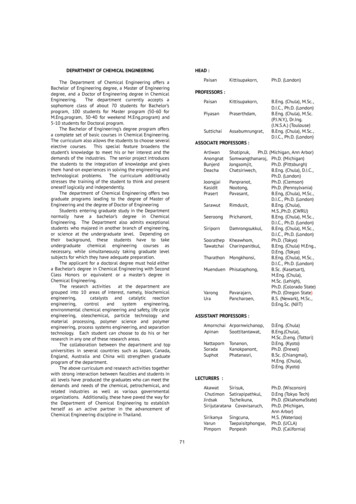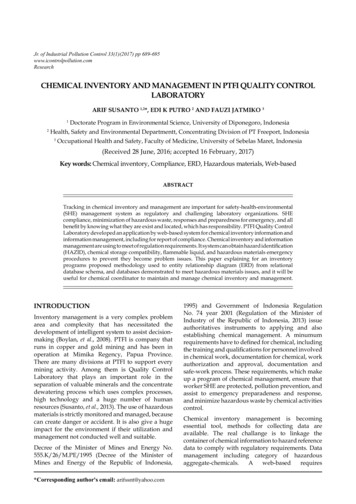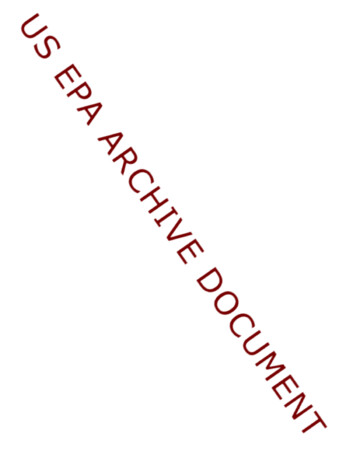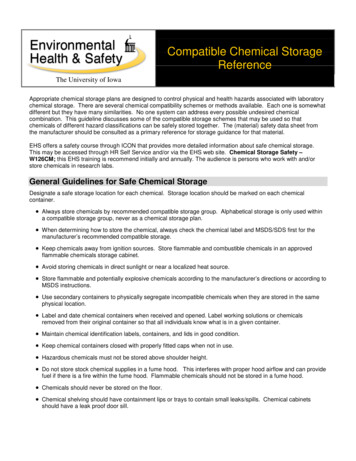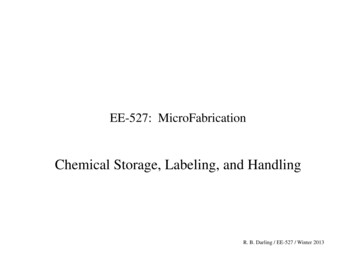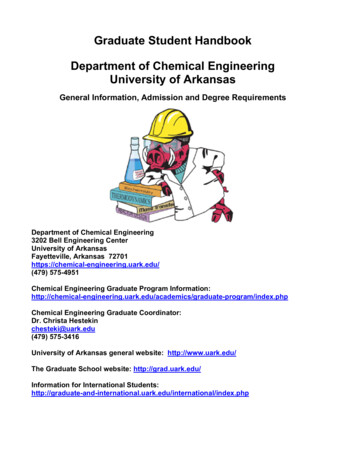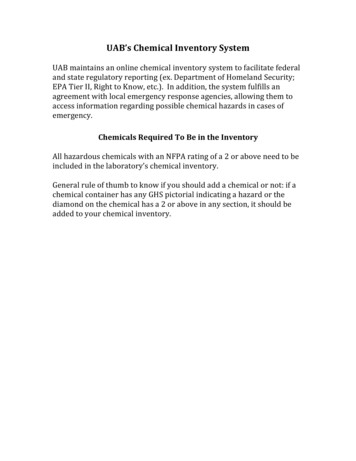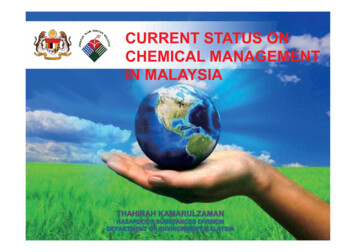
Transcription
CURRENT STATUS ONCHEMICAL MANAGEMENTIN MALAYSIA
Presentation Outline1.Background on Chemical Management in Malaysiagg Chemical Managementgin Malaysiay2. Strengthening3. Eleventh Malaysia Plan (2016-2020)4. Environmentally Hazardous Substances Notificationand Registration (EHSNR) Scheme1
BackgroundBackgroundy Many chemical substances and products arecurrently put into market in Malaysiay As a result,result there is an uncertainty on types ofchemicals used in a wide range of consumerproducts and other productsy Large percentage of existing chemicals have notbeen assessed2
Background (cont.)y Government is concerned about human and environmentalexposure from toxic substances and unregulated chemicalsused in a wide range of chemical productsy Continued use of chemicals with inherently dangerousproperties such as carcinogens, mutagens and reproductivetoxicants and substances dangerous for the environmenty Long term persistence and accumulation of many chemicalsin eco-system and humans3
Goals of Chemical ManagementMalaysia, as a developed nation by the year 2020,should ensures that chemicals are produced and usedin ways that minimize the risk and significant adverseimpactspon the environment and human health withcross-sector commitment by all stakeholders tocoordinated approaches and common principles in theadoption and strengthening of good practices for safeand ecologically sustainable chemicals management.4
Malaysia’s Chemicals Industry and Main SectorsPetroleumProducts &Natural GasChemicals ertilizersSoap detergent,cosmetics,toiletrypreparationRubber ProductsNatural RubberLatexPlastic ProductsPlastic ResinsLatex ThreadsIndustrial GasesOleo-chemicals5
DOE premises inventoryPetroleum Products & Natural Gas 439 premisesChemical and chemical products Agricultural chemical: pesticides, fertilizers: 565 premises Soap detergent, cosmetics, toiletry preparation: 247 premisesIndustrial GGases:ases: 7 premisespremises Industrial Oleo-chemicals: 198 premisesRubber products Natural Rubber Latex: 106 premises Latex Threads (synthetic): 936 premisesPlastic resin and products 1,936 premisesSource: Malaysia-Danish Environmental Cooperation Programme (DANIDA), May 20096
Challenge and GapsyLegal Framework for Chemical Management - there is NOT onelegal Act (instead of many and not coordinated) which exist toprovide a mandate for sustaining sound chemical managementin Malaysia in a holistic and integrated manneryInstitutional Coordination – fragmented framework and need toenhance coordination among agenciesa) Existing regulations provide chemical management on sectoral basisand are subject to the specific management.b) Each agency have their own legislation and control their chemicalswith the specific objectives.c) Overlapping and gaps of some regulation or regulatory scope such aslack of regulation on transportation of chemicals.7
Challenge and GapsyInformation on Chemicals - not adequately collected andcompiled to allow for their use in the management of chemicals;e.g. risk assessmenta) The industry needs to provide more information about the hazardousproperties ofpropertiesof thethe chemicalschemicals containedcontained inin theirtheir products.productsproductsyManagement of Chemicals – some industries, SMI, do notmanage chemicals in a safe and sustainable waya) There is no one stop agency that in charge for chemicals notificationsystem in Malaysia.yCapacity to Manage Chemicals – lack of knowledge, skills andmanpower to manage the different aspects of chemicals8
Challenge and Gaps (cont.)yAwareness About Chemicals - lack of awareness amongstakeholders, particularly the small and medium scaleindustries, on safe and sustainable way of managing chemicals:consumers, etcyFinancial resources – for a sound chemical management to be inplace, an adequate funding is essential. This to ensure thestrategies and action plan are implemented effectively.9
CHEMICAL MANAGEMENT IN MALAYSIARelated Legislation and AgenciesSubstance &JurisdictionMinistriesAgenciesLegislationImport, export,sales and trades –Petroleum &petroleumproductsproductsMinistry ofInternational Tradeand Industries-Petroleum (SafetyMeasures) Act 1984Import & exportsMinistry of FinanceRoyal MalaysianCustomsCustoms Act 1967IndustrialChemicalsMinistry of HumanResourcesDepartment ofSafety andHealthOccupational andSafety Health Act1994Pharmaceutical,drugs, someconsumerproductsMinistry of HealthPharmaceuticalServicesDivisionPoison Act 1952Dangerous DrugsAct 1952Food Act 198310
CHEMICAL MANAGEMENT IN MALAYSIARelated Legislation and AgenciesSubstance esMinistry ofAgriculture andAgro-chemicalsDepartment ofAgriculturePesticides Act1974ConsumersProductProductMinistry ofDomestic Trade,DomesticTradeTradeCo-operative andConsumerism-ConsumerProtection AProtectionActct1999 (Safetyissues notchemical content)Chemical Weapon(Chemical WeaponConvention)Ministry of ForeignAffairs-Chemical WeaponConvention Act2005Hazardous Waste(ScheduledWastes)Ministry of NaturalResources andEnvironmentDepartment ofEnvironmentEnvironmentalQuality Act 197411
Environmental Quality Act 1974EQA 1974EnvironmentallyHazardousSubstancesHazardous Wastesy Inthe EQA 1974, chemical defines “environmentallyhazardous substances means any natural or artificialsubstances including any raw material, whether in a solid,semi-solid or liquid form, or in the form of gas or vapour, or ina mixture of at least two of these substances, or any livingorganism intended for any environmental protection,conservation and control activity, which can cause pollution”12
Development of National Policy on ChemicalManagement9th Malaysia Plan10thMalaysia Plan11thMalaysia PlanNinth Malaysia PlanTenth Malaysia Plan(2006-2010):(2011-2015):yyGovernment will continue efforts toimprove the efficiency andgeffectiveness of waste management(JPSPN and DOE)yIncrease awareness among publicand educate them of theimportance to reduce, reuse andrecycle of waste (all stakeholders)Adoption of a global harmonizedsystem for the registration of imports,pand a safe handlingg oftransportationchemical and hazardous substances.(MITI)yApproaches and technologies to treatand convert toxic wastes into aresource for reuse. (DOE)yAppropriate incentives for the propermanagement of hazardous chemicals.(CICM)ySteps to address the indiscriminateuse of chemicals, particularly inagricultural practices, will beintensified. (DOA)Eleventh Malaysia Plan(2016-2020):y6 strategies proposed tointegrate and strengthenchemical managementframework system inMalaysia13
DOE ROLES IN TRANSFORMATIVE OF CHEMICALMANAGEMENT IN MALAYSIAStudy by Danishand MalaysiaGovernmentCooperationProgramme 20032006e e opp e tDevelopmentObjective – Aneffective andsustainablemanagementsystem isestablished that willminimize andreduce the risksfrom EHSThe scheme is tocollect informationabout EHS andprovide informationto MalaysianGovernmentDevelop guidancedocument on EHSNotification andRegistrationSchemeDevelopEHS Notificationand RegistrationScheme2009 - started theEHSNR online system- voluntary basis untila specific regulationsis gazetted andenforced2008 – final reportwas published byNRE named“Strategy & ActionPlan for ChemicalsManagement inMalaysia”Proposed tomerge databasebetween EHSNRand CIMS(DOE and DOSH)2012 – published2nd edition ofguidancedocument“Guidance ForThe Industry n &RegistrationScheme inMalaysia2014 –Incorporatechemicalmanagementpillar into 11thMalaysia NationalPlan (2016-2020)Proposedfeasibility studyon ChemicalManagement Act20xx2016 – DraftingDrafDraftit ngg2016of EHSRegulation201xframeworkEHSNR: Environmentally Hazardous SubstancesNotification and RegistrationCIMS: Chemical Information Management System
Local Actionby DOECooperationwith allstakeholdersInternationalParticipationin MEAsStrengtheningChemicalManagement15
Local Action by DOE Preliminary drafting of EHS regulations framework Merging platform for database system between EHSNR(DOE) and CIMS (DOSH) ReviewReview guidanceguidance documentdocument onon EHSEHS NotificationNotification andandRegistration Scheme Awareness and Hands on Training for industries Enhancement of the EHS website16
International Participation Basel Convention:– ratified on 8th October 1993– DOE Malaysia is designated as the competent authority– Export / import through Customs shall be accompaniedby a permit issued by DOE BBanan AAmendmentmendment ttoo tthehe BBasela se l CConvention:onvention:- ratified on 26th October 2001 Rotterdam Convention- ratified on 4th September 2002- DOE Malaysia and Pesticides Board Malaysia are the twoDesignated National Authorities (DNAs)- DOE for Industrial Chemicals- Pesticides Board for Pesticides17
International Participation Stockholm Convention- signatory since 16th May 2002- Malaysia has restricted the usage of most POPs that are listed in theconvention Chemical Weapon Convention- signatory on January 1993 and ratified on 20th April 2000Malaysia has prohibit tthehe development production,production- onstockpiling and usage of chemical weapons Intergovernmental Negotiating Committee (INC) on Legally BindingInstrument Minamata Convention on Mercury- active involvement in the INC meeting- currently prepare for legal domestic framework amongthe stakeholders before signing the convention18
Study on Chemical Management inMalaysia National Plan2003 2008Study byDanish egardingStrategy &Action Plan forChemicalManagementin sSubstancesNotification andRegistration(EHSNR)Scheme2014Study ent toGlobalPractices2015Study on newChemicalsManagementAct 201Xframework19
Action Plan for Malaysia National PlanNoAction Plan1To carry out feasibility study on a new ChemicalsManagement Act framework to fill out the gaps in Malaysianchemical management. The Act shall establish link togfrom relevant agenciesgthat involved in chemicallegislationmanagement.2To carry out a feasibility study for the establishment ofNational Chemical Management Board/Commission20
Action Plan for Malaysia National PlanNoAction Plan31) To establish National Chemical Inventory e.g. the quantityand the usage of chemicals2) Streamline existing agencies database systeminfrastructure (interface link)41) Conduct and report on risk assessment of prioritychemicals based on targeted volumes, risks and use relatedinformation2) Develop risk management measures to mitigate risk ofexposure including the phase out of hazardous substances21
Action Plan for Malaysia National PlanNo5Action Plan1) Develop training modules on life cycle management ofchemicals for stakeholders to improve managementefficiency e.g. modules to be included in training schedules2) Conduct training, workshops and seminars to builtcapacity on topics includel d toxicology,lhhazardd assessment,exposure assessment and risk assessment3) To identify, enhance and expand the scope of the existingtesting facilities4) In preparation and ratification of Stockholm andMinamata Convention22
Action Plan for Malaysia National PlanNo6Action Plan1) Develop plan for cross sectoral training, workshops and seminarin good chemical management.2) Conduct an active dialogues between chemical industries andgovernment regulatory bodies to create awareness.3) Develop syllabus for education in school and universities onchemical management.4) Organize events such as seminars and exhibitions to promoteawareness and education on hazardous substances.5) Develop incentives and economic packages to encourageindustry’s participation.23
to provide the necessary information to the Malaysian Governmentso as to enable the DOE and other agencies involved in chemicalsmanagement to identify substances of concern in the country and makedecisions on how to manage these substances in a safe and soundmanner Based on the information submitted by industry, the Department ofEnvironment (DOE) will establish a Malaysian EHS Register24
EHS Notification and Registration SchemeEHSNR database as of 30 June 2015:No. of chemical company registered todate 459No. of sector/category of industry 18No. oNo.off nnotificationsotifications bbyy iindustryndustryy intointosystem 2,743No. of EHS officially register 511No. of EHS required DetailedNotification 250No. of EHS register by oversea supplier 1925
Milestones for EHS Notification and Registration SchemeDECISION- Advocacy2018- EnforcementAuthorization- Proposed regulation oncontrolling EHS2016- BaselineBaseline datadata collectedcollectedEvaluation- Evaluate and analyze riskassessment2014Registration- Identify the needsPeriod of establishing EHS Register (voluntary)Activities -Awareness/ Outreach- Information gathering2009-Develop skill in Risk Assessment
Benefit of SchemeBenefitsSchemey There is sufficient information available on the EHSimported into or manufactured in Malaysia(Malaysian EHS Register) so as to be able toidentifyy ppriorityy substances and enable pprotectionof people and the environment from the possibleharmful effects of these substancesy It provides a mechanism for identifying, evaluatingand controlling of EHS27
Benefit of SchemeBenefitsy It helps the industry in identifying likely data gapswhich are required for GHS classification of substancesand compliance with DOSH regulations.y The scheme provides input for the risk assessment ofEHS and thereby a means of anticipating potentialproblems and facilitate the implementation of timelyand appropriate control measures for specific EHS.28
STRATEGY AND ACTION PLANS FOR EHSMANAGEMENT IN MALAYSIAto collect information from industry about thehazardous substances (EHS) that are on theMalaysian marketIntroducing a notification requirement for suchsubstances manufactured in or imported to MalaysiaMalaysia establish anRegistration SchemeEHSNotificationand
Identification and evaluation scheme for EHSSubstances imported ormanufactured in MalaysiaCriteria for EHS identification fornotification:- GHS (EU) classification- List of proscribed substancesSubstances for whichnotification is requiredSubstances selected for riskassessmentRisk management measuresfor priority substancesRef. listCriteria for selection of priorityEHS forEHSf riski k assessmentt based on:- CMR criteria- PBT criteriaP persistentB bioaccumulativeT toxicC carcinogenicM mutagenicR Reproductivetoxicity30
Scope of EHSNR SchemeThe notification requirement does not apply to substances forwhich information is already submitted to government agenciesin Malaysia by means of other legislations, unless the substanceis alsoisalso usedused forfor otherother purposespurposes notnot coveredcovered byby Pesticides,PesticidesPesticidesPoisons and Chemicals Weapons Convention ActsReference:Guidance For The Industry on The Environmentally HazardousSubstances Notification & Registration (EHSNR) Scheme inMalaysia31
DOE WEBSITE (www.doe.gov.my)32
EHSNR system (https://www.e-ehs.doe.gov.my)33
WHO SHALL AND SHALL NOT NOTIFY UNDEREHSNR?EHSEHSImporterManufacturerImporters of EHS substances ,mixtures and finished productsthat contain EHSRegisterandNotifyManufactures of EHSsubstances, mixtures andfinished products that containEHSLocally sourcedDistribution, retailingEHS
The Notification ProcessBasicNotificationD il dDetailedAnnuallyJan - JuneOnce OnlyyJan - Dec The notification for detailed is to be done once only unless newinformation that change the hazard classification are available fornotification The notification to be done online at www.doe.gov.my35
The Notification ProcessThe Notification– Basic Notification- BasicProcessNotificationThe Notification of EHS to DOE by chemical industries shall bedone in two stages:1) Basic NotificationA basic notification of EHS must first be made by allmanufacturers and importersThe data required are: Substance identification Annual tonnage in metric tons Use of the substance Concentration interval of substance in raw materials orfinished products (maximum and minimumconcentration) Country of import36
The Notification Process- Detailed Notification2) Detailed NotificationA follow-up detailed notification is also required, if the EHS is notin the EHS Reference ListDetailed Notification of EHS: In addition to basic data, thefollowing afollowingarere aalsolso required:required: Upload of MSDS Data on substance identification Data on physico-chemical properties Data on physical hazards Data on hazards to human health Data on hazards to aquatic environment Overall GHS Classification37
Way Forwards on Chemical Managementin Malaysiay1.Development of regulations on chemicals used (exceptpesticides used in homes)2. Additionalcapacity buildings in management ofchemicals, and particularly to the use of risk assessmentas a chemicals management tool3. Increasedd awareness off chemicalshl management issuesamong stakeholders.4. Database and information of hazardous chemicals inMalaysia to be made available5. Identification and assessment of risks posed by chemicals6. Strengthening and Improving International Cooperationin Chemicals38
Thahirah KamarulzamanPrincipal APrincipalAssistantssistant DirectorDirectorHazardous Substances DivisionEmail : thahirah@doe.gov.myContact: 60 3 8871 2115Website: www.e-ehs.doe.gov.myor www.doe.gov.my39
Background on Chemical Management in Malaysia 2. Strenggg g ythening Chemical Management in Malaysia 3. Eleventh MalaysiaPlan (2016-2020) . DOE premises inventory 439 premises Petroleum Products & Natural Gas Agriculturalchemical: pesticides, fertilizers: 565 premises . Chemical Information Management System Objective - An .


